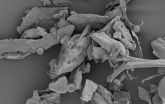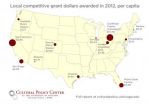(Press-News.org) WHAT: Research funded by the National Institutes of Health (NIH) suggests that exposure to specific combinations of allergens and bacteria within the first year of life may protect children from wheezing and allergic disease. These observations come from the Urban Environment and Childhood Asthma (URECA) study, which aims to identify factors responsible for asthma development in children from inner-city settings, where the disease is more prevalent and severe. Since 2005, the URECA study has enrolled 560 children from four cities—Baltimore, Boston, New York and St. Louis. The children all have at least one parent with asthma or allergies, placing them at high risk for developing asthma. The study is following the children from birth, and the current publication evaluates the group through three years of age.During early life, recurrent wheezing and sensitivity to common allergens are risk factors for developing asthma. In the current study, the researchers measured the frequency of wheezing episodes and levels of exposure to five common inner-city allergens—cat, cockroach, dog, dust mite and mouse. Surprisingly, they found that exposure to cockroach, mouse and cat during the first year of life was associated with a lower risk of recurrent wheezing by age three.
A smaller study within the URECA cohort tested whether bacteria, measured in house dust, influence asthma risk. Researchers sorted 104 children into four groups: no wheezing or sensitivity to allergens, wheezing only, sensitivity to allergens only, or both wheezing and sensitivity to allergens. They found that children with no wheezing or sensitivity to allergens at age three were more likely to have encountered high levels of allergens and a greater variety of bacteria, particularly those belonging to the Bacteriodes and Firmicutes groups, during their first year of life. These observations support the emerging concept that early-life exposure to high bacterial diversity may protect kids from developing allergies. Most importantly, the findings show that this protection is even stronger when children also encounter high allergen levels during this time.
The URECA study, funded by NIH's National Institute of Allergy and Infectious Diseases through its Inner-City Asthma Consortium, is no longer recruiting, but more information is available at ClinicalTrials.gov using the identifier NCT00114881. Additional funding was provided by the NIH's National Center for Advancing Translational Sciences. The research was conducted by investigators from several institutions, including the University of Wisconsin-Madison; the University of California, San Francisco; and Johns Hopkins University.
INFORMATION:
ARTICLE:SV Lynch et al. Effects of early life exposure to allergens and bacteria on recurrent wheeze and atopy in urban children. Journal of Allergy and Clinical Immunology DOI: 10.1016/j.jaci.2014.04.018 (2014).
WHO:NIAID Director Anthony S. Fauci, M.D., and Peter J. Gergen, M.D., Medical Officer in the Asthma and Airway Biology Section in NIAID's Division of Allergy, Immunology and Transplantation, are available to discuss the findings.
CONTACT:To schedule interviews, contact Linda Huynh, (301) 402-1663, niaidnews@niaid.nih.gov.
NIAID conducts and supports research—at NIH, throughout the United States, and worldwide—to study the causes of infectious and immune-mediated diseases, and to develop better means of preventing, diagnosing and treating these illnesses. News releases, fact sheets and other NIAID-related materials are available on the NIAID Web site at http://www.niaid.nih.gov.
About the National Institutes of Health (NIH): NIH, the nation's medical research agency, includes 27 Institutes and Centers and is a component of the U.S. Department of Health and Human Services. NIH is the primary federal agency conducting and supporting basic, clinical, and translational medical research, and is investigating the causes, treatments, and cures for both common and rare diseases. For more information about NIH and its programs, visit http://www.nih.gov.
NIH...Turning Discovery Into Health ® END
Early exposure to certain bacteria may protect toddlers from wheezing
NIH-funded study provides evidence of protective effects among inner-city children
2014-06-06
ELSE PRESS RELEASES FROM THIS DATE:
New report: Local public grants for art varies across US
2014-06-06
Local direct public funding provided through grants for the arts in Chicago is low compared to peer regions in both total dollar and per capita terms, according to a new report from the Cultural Policy Center at the University of Chicago.
The study tracks direct public funding for the arts in 13 regions from 2002-2012. It provides a nuanced look at how much money comes to the nonprofit arts from national, state and local arts agencies, with an emphasis on the important role of local arts agencies. While most studies of public funding for the arts use appropriations made ...
HIV transmission networks mapped to reduce infection rate
2014-06-06
Researchers at the University of California, San Diego School of Medicine have mapped the transmission network of human immunodeficiency virus (HIV) in San Diego. The mapping of HIV infections, which used genetic sequencing, allowed researchers to predictively model the likelihood of new HIV transmissions and identify persons at greatest risk for transmitting the virus.
The findings are published online in the June 5 issue of the journal PLOS ONE.
"The more we understand the structure and dynamics of an HIV transmission network, the better we can identify 'hot spots' ...
Alcohol may protect trauma patients from later complications
2014-06-06
Injured patients who have alcohol in their blood have a reduced risk for developing cardiac and renal complications, according to a study from the University of Illinois at Chicago School of Public Health. Among patients who did develop complications, those with alcohol in their blood were less likely to die.
The study is published in the June issue of the journal Alcohol.
"After an injury, if you are intoxicated there seems to be a substantial protective effect," says UIC injury epidemiologist Lee Friedman, author of the study. "But we don't fully understand why this ...
Is glaucoma a brain disease?
2014-06-06
Rockville, Md. — Findings from a new study published in Translational Vision Science & Technology (TVST) show the brain, not the eye, controls the cellular process that leads to glaucoma. The results may help develop treatments for one of the world's leading causes of irreversible blindness, as well as contribute to the development of future therapies for preserving brain function in other age-related disorders like Alzheimer's.
In the TVST paper, Refined Data Analysis Provides Clinical Evidence for Central Nervous System Control of Chronic Glaucomatous Neurodegeneration, ...
Clinical review published in JAMA
2014-06-06
Many women experience bothersome urine loss with laughing, coughing and sneezing (stress urinary incontinence) AND on their way to the bathroom (urge urinary incontinence). When women experience both types of urine leakage, their condition is called mixed urinary incontinence. It is estimated that 20 to 36 percent of women suffer from mixed urinary incontinence, which is challenging to diagnose and treat because symptoms vary and guidelines for treatment are not clear.
A clinical review entitled "Clinical Crossroads – Female Mixed Urinary Incontinence" by Deborah L. ...
Prostate cancer biomarkers identified in seminal fluid
2014-06-06
Improved diagnosis and management of one of the most common cancers in men – prostate cancer – could result from research at the University of Adelaide, which has discovered that seminal fluid (semen) contains biomarkers for the disease.
Results of a study now published in the journal Endocrine-Related Cancer have shown that the presence of certain molecules in seminal fluid indicates not only whether a man has prostate cancer, but also the severity of the cancer.
Speaking in the lead-up to Men's Health Week (9-15 June), University of Adelaide research fellow and lead ...
Toward a better drug against malaria
2014-06-06
This news release is available in German.
A research team led by Prof. Dr. Carola Hunte of the University of Freiburg/ Germany has succeeded in describing how the antimalarial drug atovaquone binds to its target protein. The scientists used x-ray crystallography to determine the three-dimensional structure of the protein with the active substance bound. The drug combination atovaquone-proguanil (Malarone®) is a medication used worldwide for the prevention and treatment of malaria. The data and the resulting findings concerning the mode of action of atovaquone could ...
Football for untrained 70-year-old men
2014-06-06
Research carried out by the Copenhagen Centre for Team Sport and Health in Denmark shows that untrained elderly men get markedly fitter and healthier as a result of playing football (soccer). After only 4 months of twice-weekly 1-hour training sessions, the men achieved marked improvements in maximum oxygen uptake, muscle function and bone mineralization.
Later today, three scientific articles will be published in the Scandinavian Journal of Medicine & Science in Sports describing the fitness and health effects of football training for 63‒75-year-old untrained men. ...
Deadly diseases overlooked for too long, scientists say
2014-06-06
Decades of neglect have allowed infectious diseases to devastate the lives of thousands of people in the developing world, a study reveals.
Researchers say three diseases in particular – anthrax, brucellosis and bovine tuberculosis – have failed to receive the official recognition and funding needed to combat them effectively.
All three impact greatly on human and animal health in developing nations, posing a major threat to safe and plentiful food supplies.
The disorders – known as zoonotic diseases – are spread between animals and humans. They are common ...
Saving trees in tropics could cut emissions by one-fifth, study shows
2014-06-06
Reducing deforestation in the tropics would significantly cut the amount of carbon dioxide emitted into the atmosphere – by as much as one-fifth – research shows.
In the first study of its kind, scientists have calculated the amount of carbon absorbed by the world's tropical forests and the amounts of greenhouse gas emissions created by loss of trees, as a result of human activity.
They found that tropical forests absorb almost two billion tonnes of carbon each year, equivalent to one-fifth of the world's carbon emissions, by storing it in their bark, leaves and soil. ...
LAST 30 PRESS RELEASES:
When is it time to jump? The boiling frog problem of AI use in physics education
Twitter data reveals partisan divide in understanding why pollen season's getting worse
AI is quick but risky for updating old software
Revolutionizing biosecurity: new multi-omics framework to transform invasive species management
From ancient herb to modern medicine: new review unveils the multi-targeted healing potential of Borago officinalis
Building a global scientific community: Biological Diversity Journal announces dual recruitment of Editorial Board and Youth Editorial Board members
Microbes that break down antibiotics help protect ecosystems under drug pollution
Smart biochar that remembers pollutants offers a new way to clean water and recycle biomass
Rice genes matter more than domestication in shaping plant microbiomes
Ticking time bomb: Some farmers report as many as 70 tick encounters over a 6-month period
Turning garden and crop waste into plastics
Scientists discover ‘platypus galaxies’ in the early universe
Seeing thyroid cancer in a new light: when AI meets label-free imaging in the operating room
Neutrophil-to-lymphocyte ratio may aid risk stratification in depressive disorder
2026 Seismological Society of America Annual Meeting
AI-powered ECG analysis offers promising path for early detection of chronic obstructive pulmonary disease, says Mount Sinai researchers
GIMM uncovers flaws in lab-grown heart cells and paves the way for improved treatments
Cracking the evolutionary code of sleep
Medications could help the aging brain cope with surgery, memory impairment
Back pain linked to worse sleep years later in men over 65, according to study
CDC urges ‘shared decision-making’ on some childhood vaccines; many unclear about what that means
New research finds that an ‘equal treatment’ approach to economic opportunity advertising can backfire
Researchers create shape-shifting, self-navigating microparticles
Science army mobilizes to map US soil microbiome
Researchers develop new tools to turn grain crops into biosensors
Do supervised consumption sites bring increased crime? Study suggests that’s a myth
New mass spec innovation could transform research
Maternal nativity, race, and ethnicity and infant mortality in the US
Migration-related trauma among asylum seekers exposed to the migrant protection protocols
Jupiter’s moon Europa has a seafloor that may be quiet and lifeless
[Press-News.org] Early exposure to certain bacteria may protect toddlers from wheezingNIH-funded study provides evidence of protective effects among inner-city children



